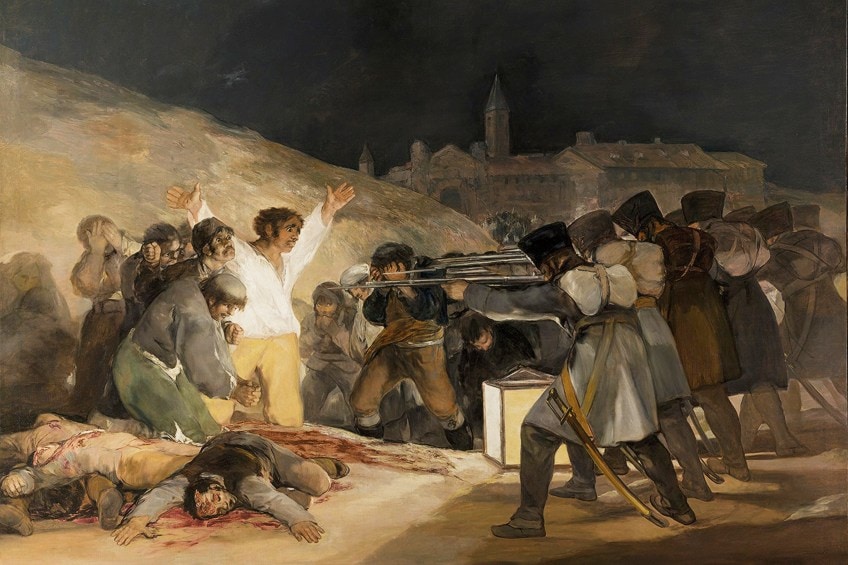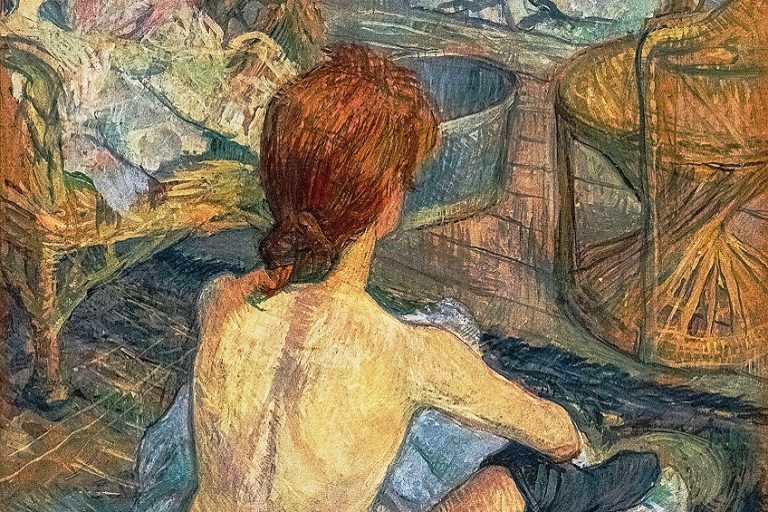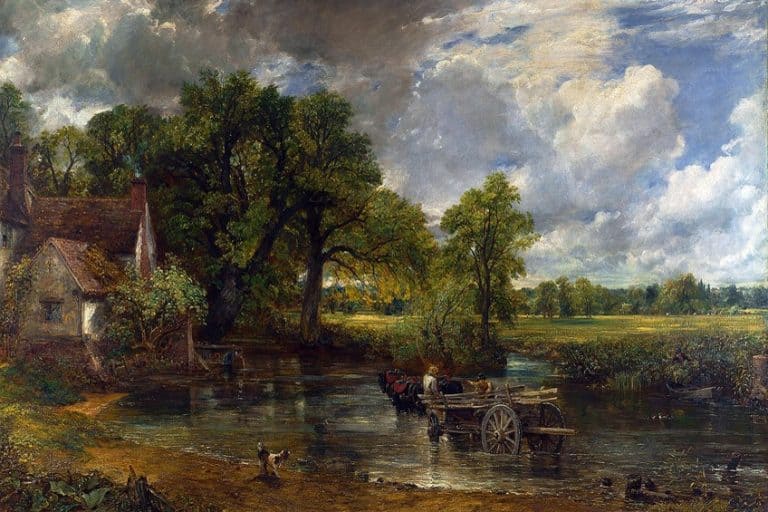“The Third of May 1808” Francisco Goya – Observing a Massacre
It is an image that is not so easy to forget, instilling not only fear and tragedy but the traumatic realizations that undoubtedly come when you know you are next in line in a bloody execution. This underlies the events portrayed in the painting The Third of May 1808 (1814) by the Spanish painter known as Francisco de Goya, which is what we will discuss in this article.
Artist Abstract: Who Was Francisco de Goya?
Francisco José de Goya y Lucientes, a Spanish artist, was born on March 30, 1746 and died on April 16, 1828. Usually referred to as Francisco de Goya, this artist grew up in the town called Fuendetodos, Aragon, Spain. He studied art when he was 14 years old under the tutelage of José Luzán and then he studied with one of the forerunners of Neoclassicism Anton Raphael Mengs.
In 1774, he painted cartoons for the Royal Tapestry factory and then painted for Charles III during 1786, and then during 1799, he was the First Court Painter under Charles IV. Goya was remembered as not only one of the “Old Masters” of painting but also one of the forerunners of Modern art.
His style was centered on the tenets of traditional painting, but he utilized a more expressive style of painting and subject matter that was more subjective.

The Third of May 1808 (1814) by Francisco de Goya in Context
It is considered a “timeless” painting, The Third of May 1808, with its companion The Second of May 1808, both painted in 1814 belonging to the rich collection of Francisco de Goya paintings. However, the above-mentioned paintings relay and portray pertinent historical wartime events that will never be forgotten.
Below, we discuss The Third of May 1808 painting analysis by first providing a contextual analysis, looking at when and why it was painted and the events that inspired it. We will then discuss a formal analysis of Goya’s Third of May 1808 painting looking closely at the subject matter and the artist’s stylistic approach and application.
| Artist | Francisco de Goya |
| Date Painted | 1814 |
| Medium | Oil on canvas |
| Genre | History Painting |
| Period / Movement | Romanticism |
| Dimensions | 268 x 347 centimeters |
| Series / Versions | Part of companion painting The Second of May 1808 (1814) |
| Where Is It Housed? | Museo Nacional del Prado, Madrid, Spain |
| What It Is Worth | Based on the prices from other Francisco Goya artworks sold, its estimated worth is possibly in the millions of dollars. |
Contextual Analysis: A Brief Socio-Historical Overview
Before we look at the events portrayed in Goya’s Third of May 1808 painting, it is important to place it within the art period it was painted in, which was Romanticism. Romanticism began around the late 1700s until around the 1830s.
It was a reaction by artists against Neoclassicism and how it portrayed and prescribed how history paintings should be painted.
Romanticism sought to express deeper, more subjective, aspects of life, specifically social and political events. However, it comprised a combination of facets that defined it as a new art style. Artists sought a new expression and freedom; it was tied to inherent emotions. Subject matter ranged from the veneration of nature to the ideas of justice, nationality, and various events.
The Historical Events Portrayed by Goya
The Peninsular War started in 1808 through to 1814. It was a war between Portugal, Britain, and Spain against the French Empire, the latter being led by Napoleon Bonaparte. Napoleon’s army infiltrated Spain during 1808, overthrowing its monarchy and making Joseph Bonaparte, his brother, the king.
Napoleon’s army invaded Portugal during 1807, however, Napoleon’s army also went through Spain under the guise of infiltrating Portugal, because Portugal was trading with Britain, which was something Napoleon wanted to stop. However, Napoleon invaded Spain too, which led to the Spanish revolting against the French.
There were numerous uprisings from the Spanish, however, the stronghold of Napoleon’s troops managed to quell any form of revolt and executed the Spanish who sought to fight back for their freedom and their country.
The Dos de Mayo Uprising, otherwise known as The Second of May Uprising in English, is reported to have started in Madrid at the Royal Palace, but the crowds apparently moved to the city and were seized by French troops; many died during the process. We see this in one of the related Francisco Goya artworks, The Second of May 1808 (The Charge of the Mamelukes) (1814).
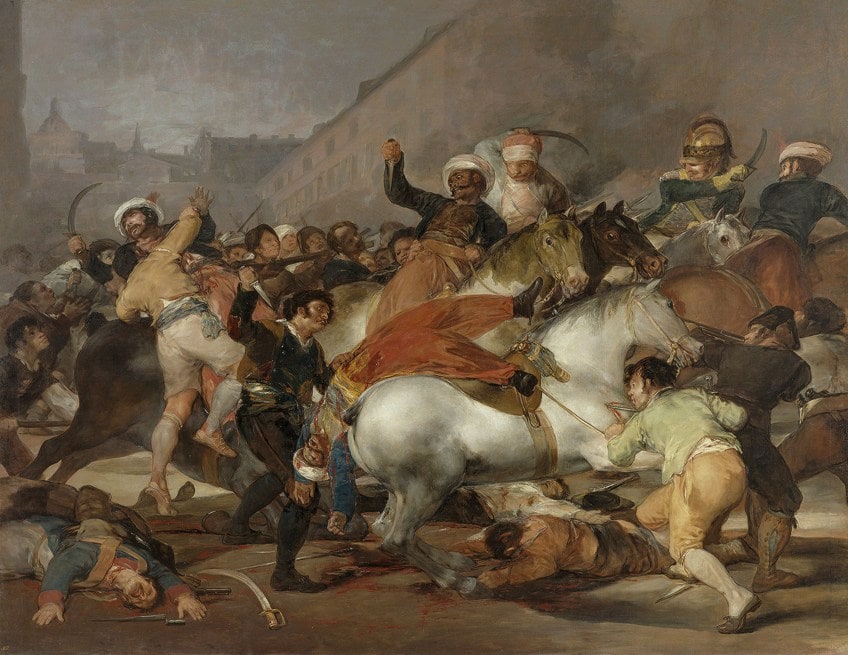
The French commander Joachim Murat ordered the French troops to kill all those remaining, now prisoners, who had weapons during the revolt. He is reported as having said, “The population of Madrid, led astray, has given itself to revolt and murder. French blood has flowed. It demands vengeance. All those arrested in the uprising, arms in hand, will be shot”.
These events took place the following day, on the third of May, which is what takes place in Goya’s “Third of May 1808” painting.
Although this is a brief and truncated version of the complex events that occurred during Napoleon’s invasions and eventually his defeat, the important point to remember here is the context within which Spanish painter Goya created The Third of May 1808, as well as the companion painting The Second of May 1808, which is equally significant, mentioned above.
Formal Analysis: A Brief Compositional Overview
As one of the many Francisco de Goya paintings, The Third of May 1808 is widely acclaimed by many art sources as being one of the “first” modern paintings. The subject matter and artistic technique depart from what was expected at the time from history paintings, depicting a scene charged with emotion – let us take a closer look.

Subject Matter
In The Third of May 1808, Francisco Goya depicts a scene taking place at night, or as some sources have suggested it is early morning; the sky is depicted as a black mass above the massacre below.
If we look closely, there are four distinguishing groups of people comprising the composition.
These are, namely, the French troops, taking up the right-hand side of the composition. There appear to be more than six men standing in an orderly fashion with their backs towards us, the viewers. We cannot distinguish any facial features at all. They are holding and aiming their rifles, ready to shoot at the group of men opposite them.
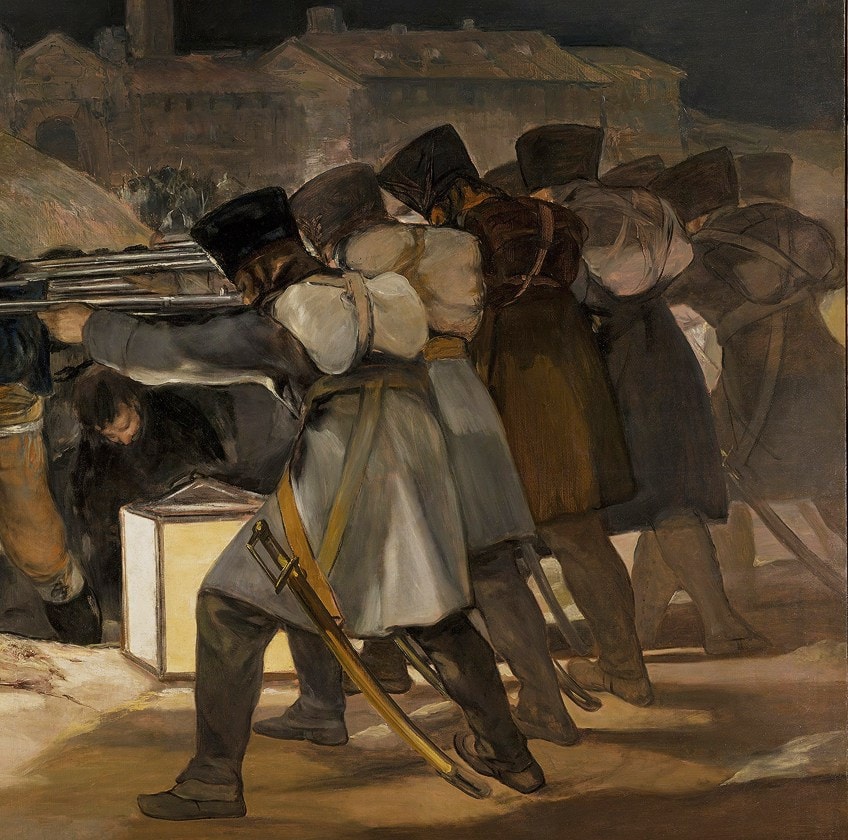
This leads to the next group of figures who make up most of the left-hand side of the composition. Notably, the primary figure from this group, who is going to be executed in mere minutes, kneels on the light brown sandy ground. He wears a white shirt and beige pants with both of his arms widely outstretched in complete surrender.
He looks directly at the soldiers, although his eyes and mouth show an expression seemingly of a fearful, yet accepted surrender.
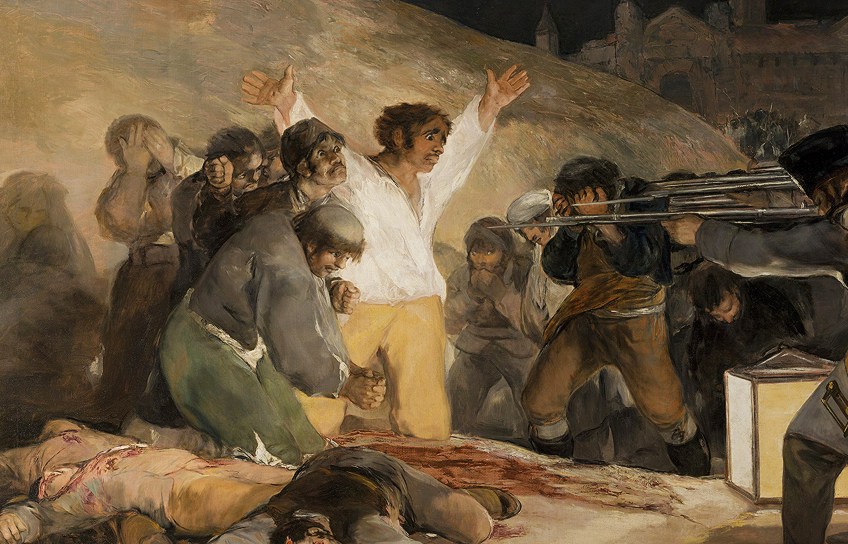
To his right (our left) and behind him, there is a procession of other figures who are also waiting to be executed, however, they do not seem to possess the same bravery as the central figure. They appear to be fraught with fear and Goya depicts this clearly in their facial expressions; some also hold their hands over their faces.
For example, the man standing to the central Christ-like figure’s right (our left) peers at the soldiers and creates an awareness of the other figures behind him. His eyes are wide, and his head is tilted slightly upwards as if he is in a state of frozen fear at what is going on. Beside him, to his right, is another man kneeling and looking downwards, appearing to hold his hand.

If we look further to the above-mentioned man’s right, which now moves more into the foreground, we will notice several dead bodies starting to pile on one another, this is also the other group of figures. One of the dead bodies is lying with his face facing us, the viewers, and his arms are both outstretched on the ground.
There is also a large and inevitably growing pool of blood from the executions, which only adds to the dramatic effect of the painting.
There is another group of figures standing to the central figure’s left, our right. They are also clearly awaiting their execution, and we can see their fear and terror. The man in front stands with both hands cupping his face.
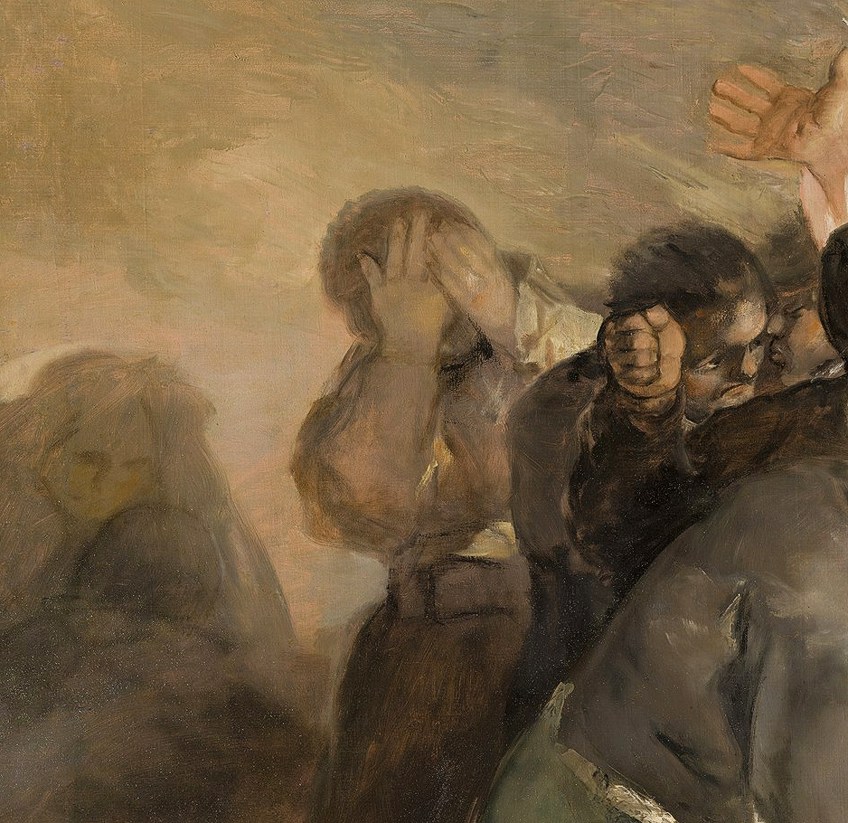
To his right, there is a figure with both hands by his mouth, hunched in fear. Next to his right is what appears to be a friar. It is not clear how far this procession of people leads into the far distance as their shakos, which is a term referring to their headgear, create a border-like effect and block off our view of the rest of the prisoners. This leads our eyes to the background, where we see a large building with a tower in the far distance. We can also notice a group of people near this building, they appear to hold torches.
The environment is also important to note here, as Goya does not depict a complex background.
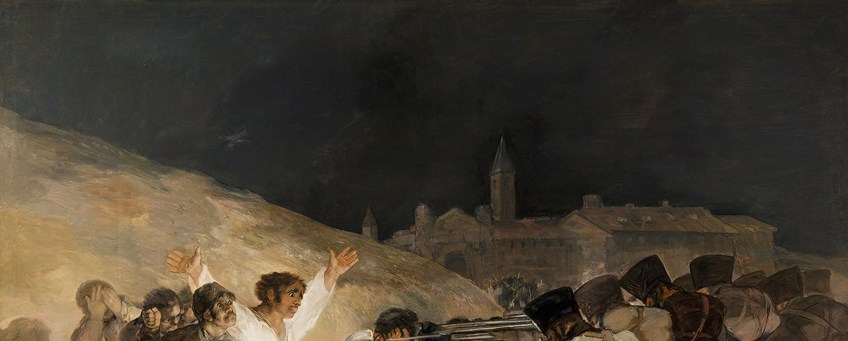
The surrounding environment is simply arranged and largely composed of the building in the background. To the right-hand side in the foreground, a mounding hill acts as a barrier against which the prisoners are shot.
This same hill also encloses the scene in the foreground, bringing our focus squarely onto the central figures.
Furthermore, there is a squared-shaped lantern placed almost in the center of the composition, it is between the soldiers and figures about to be shot. The lantern lights up almost the entire bottom left-hand side of the composition, spotlighting the central Christ-like figure creating a more dramatic effect about what is to occur. Additionally, this leaves the soldiers standing in the shadows.
Color and Light
When we look at the color and light in The Third of May 1808 Francisco Goya utilized the chiaroscuro technique to create the contrast of light and dark. His color palette also consists of earthy shades and neutral tones.
Any colors utilized are in lighter tones. For example, the beige from the central figure’s pants, the light green pants of the figure to his right (our left), and then the red from the blood, which seemingly creates a more dramatic area of color, while simultaneously not being too bright.
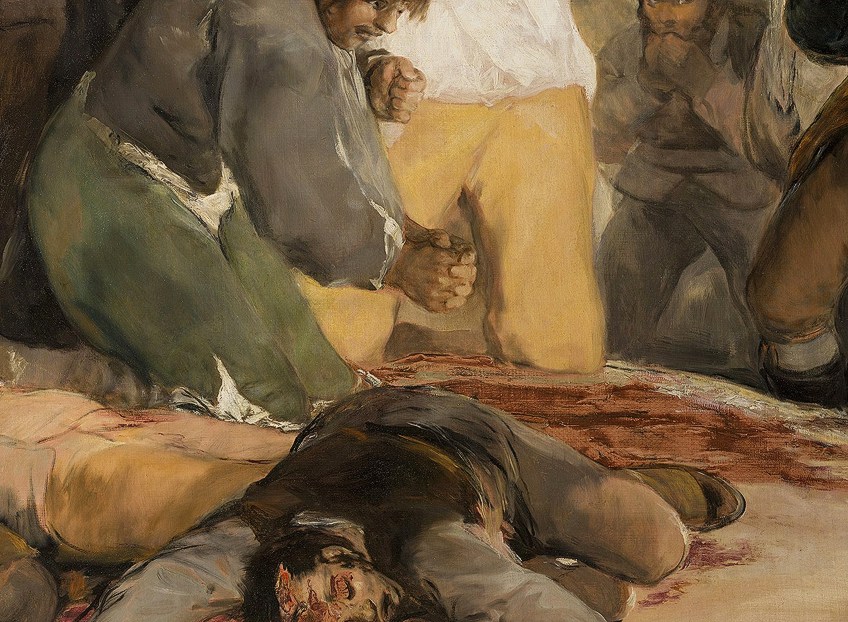
There are dark areas surrounding the central scene, which are enhanced by the lighter colors directly tied to the lantern on the ground. In fact, the lanterns appear to be the only light source in this composition. This is echoed in the stark white of the central figure’s shirt, which appears to also be the only “brighter” color compared to the other neutral tones.
We also see the transition from light to dark on the ground.
For example, nearing the foreground, we see the light beams from the lantern on the ground create streaks of shadows. Goya painted these masterfully, as it almost appears as if the shadow creates a dividing line between the victims and the soldiers.

Furthermore, color and light are connected to the symbolism here portrayed by the different groups of men, namely, the ones executed and the soldiers. The executed figures are highlighted from the lantern’s light; we can see the faces of the victims illuminated by the lantern’s light.
The soldiers stand in the darkness or the shadows, and they become almost like the faceless and nameless perpetrators in the execution of people who could be anyone if this painting was viewed without its historical context; all we know about the soldiers come from their uniforms.
Brushwork and Texture
The brushwork is visible in Goya’s Third of May 1808 composition, especially near the areas where the lantern’s light illuminated the scene. For example, the brushwork on the hill just behind the men being executed provides it with a beautiful textural quality.
This is also evident in the ground Goya painted; we can see his brushstrokes appear looser, giving it a richer quality.
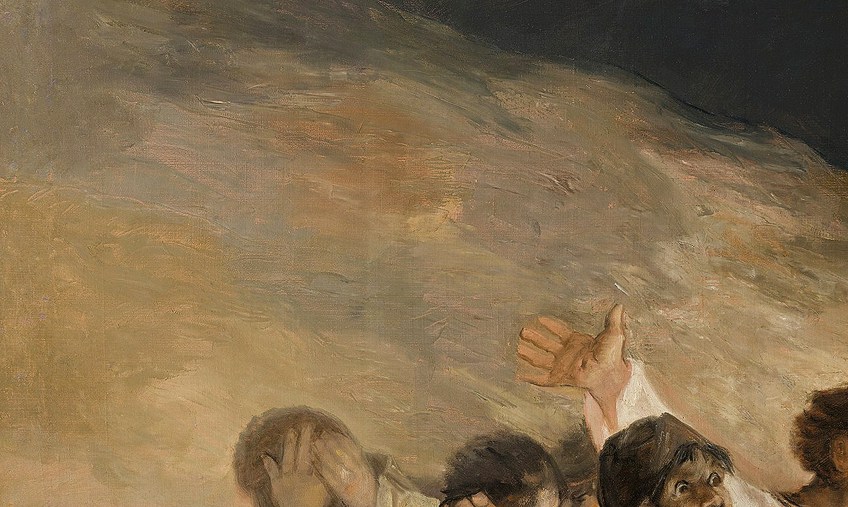
However, we see this utilization of looser, more expressive, brushstrokes in the entire composition. Other examples include smaller modeling details like the central figure’s brown hair as well as the clothing of most of the figures being executed. Their clothes appear more unkempt than the soldier’s clothing, which appears to be painted with finer brushstrokes.
Linear Perspective
Perspective and depth, or three-dimensionality, are indicated in Goya’s Third of May 1808 composition. We see this as the background diminishes in scale, the figures and buildings all appear smaller in size, and as we near the forefront the figures are larger.
Furthermore, a three-dimensionality is created by the various figures and their “overlapping”. For example, the soldiers standing in a line next to one another, the groups of men standing to the right waiting for their demise, as well as the illuminated figures in the forefront.
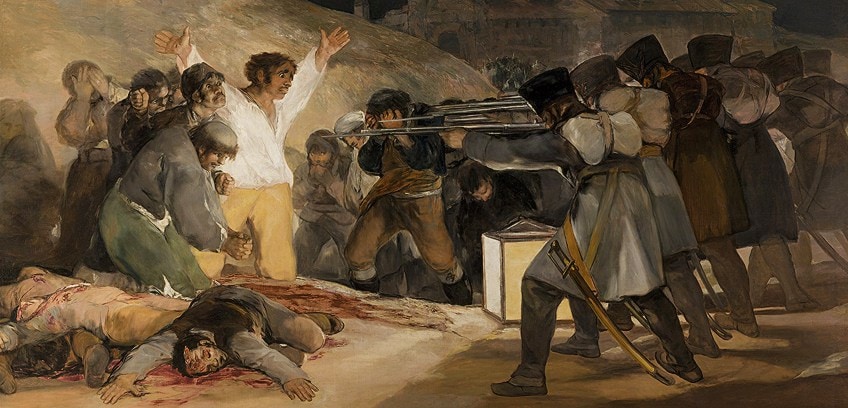
Goya depicted the figures as almost on top of one another, this also applies to the group of dead bodies, which creates a sense of space showing us the depth of the scene. However, there is also strong linearity created especially diagonally.
The diagonal lines are created by the soldiers to the right.
Their rifles also create a strong horizontal line as they are all lined up simultaneously, which leads our eyes in the direction towards the central character about to be shot. The central character mentioned above holds both arms up, and this has been described as a “V” shape, which is echoed in the dead man in the foreground whose arms are also in a “V” shape on the ground. Additionally, this is also similar to a “Y” shape.

The shadows also create linearity as we see in the seeming dividing line of light and dark mentioned earlier. We also see how color is utilized to indicate depth, as the figures become hazier in color to indicate recession into the background; they are clearer in color and shape more into the foreground space.
This is also highlighted by what is described as “contour lines”, we see these outlines delineating the soldiers’ shapes, giving their figures more definition.
The Third of May 1808 Symbolism: More About the Christ-like Figure
There is also inherent symbolism in Goya’s Third of May 1808 painting mentioned above. As we mentioned several times, the central figure appears Christ-like, in fact, this figure has been widely described as such. We see this Christ-like quality in the figure’s outstretched arms, resembling the outstretched arms of Jesus Christ when he was crucified. Furthermore, if we look closely, the figure’s right hand depicts a mark that resembles the stigmata, which were the wounds on Jesus’ hands from his crucifixion.

This points to what the central figure may symbolize, which is a symbol of sacrifice. He may be sacrificing himself for others, for his country, as some sources suggest, although he is no Messiah from the Bible, he is only a mere Spaniard, revolting and fighting for his country’s freedom.
Goya gave the everyday man a platform on which to be a hero, so to say, giving him the embodiment of being the martyr and savior. Furthermore, there are other connections to Biblical stories, for example, when Christ was arrested by the Roman soldiers who also had torches and lanterns.
Could we even connect the group in the background, who appears to also be holding torches, to the groups who came for Jesus? Perhaps Goya is not depicting the same events, but he is conveying a similar message of martyrdom and execution.
Goya: The Anti-War Hero
The Third of May 1808 painting analysis above has aimed to give a brief overview of Francisco de Goya’s artistic skills in what has been regarded as one of the pioneering paintings of the Modern era. However, it also depicts the importance of national dignity and respect towards historical events. It was Goya who reportedly presented the idea to paint The Second of May 1808 and The Third of May 1808 to the Spanish government, who then commissioned both paintings.
Goya’s Third of May 1808 painting also influenced notable artists like Édouard Manet and his painting The Execution of Emperor Maximilian (1868 to 1869) and Pablo Picasso’s Guernica (1937) and Massacre in Korea (1951), all of which are political paintings related to execution from war.
We also see contemporary artists finding resonance with Goya’s subject matter, borrowing it as references to their own experiences. For example, the Pop artist Robert Ballagh’s The Third of May After Goya (1970) depicts similar subject matter to raise awareness about the massacre that took place in Derry, Ireland, during 1969, also referred to as Bloody Sunday.
Both Francisco de Goya paintings mentioned in this article undoubtedly showed the world scenes rife with the iniquities from war. The Third of May 1808 flagged a change in the art world and seemingly gave others permission, so to say, to express their own inner turmoil from the effects of war and conflict between countries, but ultimately between human beings, a collective family.
Goya left a great legacy, and perhaps through his painting he has become the anti-war hero, not only highlighting Spain’s history in a harsh yet truthful light but also providing the template for other artists to show the world their stories.
Frequently Asked Questions
Who Painted The Third of May 1808 (1814)?
The Third of May 1808 (1814) was painted by the Spanish painter Goya. His full name was Francisco de Goya or also just named Francisco Goya. He was born in March 1746 and died in April 1828. He was from the Romanticism art movement during the 1800s.
What Is Goya’s Third of May 1808 (1814) Painting About?
Francisco Goya’s The Third of May 1808 (1814) takes place during the Peninsular War when Napoleon Bonaparte invaded Spain and Portugal. It depicts a massacre in Madrid on the third of May 1808, between revolutionary Spaniards and French soldiers who were ordered on the second of May to execute all those who had weapons during the revolt. It depicts the reality of wartime and the lives lost due to executions.
What Does Goya’s Third of May 1808 (1814) Painting Symbolize?
Francisco Goya’s Third of May 1808 (1814) has been described as symbolizing the ideas of martyrdom. The figure in the white shirt with outstretched arms resembles Jesus Christ’s crucifixion and ultimately his execution by Roman soldiers. However, in Goya’s composition, it is an ordinary man being murdered by French soldiers, willing to die for his country and freedom.
Alicia du Plessis is a multidisciplinary writer. She completed her Bachelor of Arts degree, majoring in Art History and Classical Civilization, as well as two Honors, namely, in Art History and Education and Development, at the University of KwaZulu-Natal, South Africa. For her main Honors project in Art History, she explored perceptions of the San Bushmen’s identity and the concept of the “Other”. She has also looked at the use of photography in art and how it has been used to portray people’s lives.
Alicia’s other areas of interest in Art History include the process of writing about Art History and how to analyze paintings. Some of her favorite art movements include Impressionism and German Expressionism. She is yet to complete her Masters in Art History (she would like to do this abroad in Europe) having given it some time to first develop more professional experience with the interest to one day lecture it too.
Alicia has been working for artincontext.com since 2021 as an author and art history expert. She has specialized in painting analysis and is covering most of our painting analysis.
Learn more about Alicia du Plessis and the Art in Context Team.
Cite this Article
Alicia, du Plessis, ““The Third of May 1808” Francisco Goya – Observing a Massacre.” Art in Context. January 26, 2022. URL: https://artincontext.org/the-third-of-may-1808-francisco-goya/
du Plessis, A. (2022, 26 January). “The Third of May 1808” Francisco Goya – Observing a Massacre. Art in Context. https://artincontext.org/the-third-of-may-1808-francisco-goya/
du Plessis, Alicia. ““The Third of May 1808” Francisco Goya – Observing a Massacre.” Art in Context, January 26, 2022. https://artincontext.org/the-third-of-may-1808-francisco-goya/.


